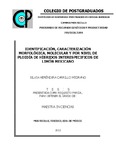Identificación, caracterización morfológica, molecular y por nivel de ploidía de híbridos interespecíficos de limón mexicano.
Abstract
El desarrollo de variedades tolerantes mediante hibridaciones interespecíficas e intergenéricas puede ayudar a enfrentar y reducir los impactos de enfermedades que amenazan al cultivo de limón mexicano [Citrus aurantifolia (Christm) Swingle]. La identificación temprana de plantas híbridas permitirá eficientar los trabajos en el programa de mejoramiento genético de este cítrico. El objetivo del estudio fue identificar, caracterizar morfológica, molecular y por nivel de ploidía híbridos interespecíficos de limón mexicano. Para la identificación de híbridos se utilizaron algunos caracteres morfológicos presentes en los progenitores, como presencia de antocianinas en brotes tiernos, yemas vegetativas y botones florales, hojas compuestas y coriáceas de mayor espesor y glándulas de aceite abultadas. Las plantas de cruzas entre genotipos 2x X 4x y su recíproca con características de poliploidía, se sometieron al análisis de citometría de flujo. De las 326 plantas analizadas, 132 (55.85%) se identificaron como plantas triploides. Se utilizó la técnica de marcadores genéticos denominados microsatélites (SSR). Los iniciadores utilizados fueron TAA41, TAA45, cAGG9 y TAA52. Los cuatro iniciadores permitieron la identificación de plantas híbridas, sin embargo, los iniciadores TAA45 y cAGG9 lograron identificar el mayor número de plantas híbridas con 145 y 130 respectivamente. En general todas las plantas que resultaron hibridas comparten caracteres morfológicos, aunque no está claro cómo se heredan algunas de esas características, pues cuando se cruzan se crean nuevas combinaciones genéticas donde segregan y se recombinan de manera aleatoria sus alelos y generan una gran diversidad de fenotipos. _______________ IDENTIFICATION, MORPHOLOGICAL, MOLECULAR AND PLOIDY LEVEL OF INTERSPECIFIC HYBRIDS OF MEXICAN LIME. ABSTRACT: The development of tolerant varieties through interspecific and intergeneric hybridizations can help to address and reduce the impact of diseases threatening the production of Mexican lime [Citrus aurantifolia (Christm) Swingle]. Early identification of hybrid plants will enable more efficient work in the breeding program of this citrus. The objective of the study was to identify, characterize morphologicaly and moleculary and ploidy level of interspecific hybrids of Mexican lime. For identification of hybrids some morphological characters present in the parents, as presence of anthocyanins in shoots buds and vegetative buds, leaves composed and leathery thicker and oil glands bulky were evaluated. Plants cross between genotypes 4x x 2x and their interaction with polyploidy characteristics, the flow cytometric analysis were subjected. Of the 326 plants analyzed, 132 (55.85%) were identified as triploid plants. The technique of genetic markers called microsatellites (SSR) was used. The primers used were TAA41, TAA45, cAGG9 and TAA52. All primers allowed the identification of hybrid plants, however, cAGG9 and TAA45 identified most hybrids plants 145 and 130 hybrids respectively. In general, all hybrid plants shared morphological characters, though it is unclear how some of these characteristics are inherited, because when they cross new genetic combinations are segregated and recombined randomly their alleles thus creating and generating great diversity of phenotypes.
Collections
- Tesis MC, MT, MP y DC [138]


